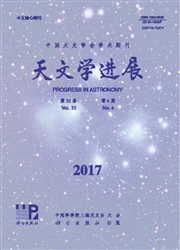

 中文摘要:
中文摘要:
该文简述了巡天观测和星表编制的历史和意义。介绍了天体测量星表与巡天观测的最新进展,如位置星表URAT、Pan—STARSS、LSST;自行星表LSPM、PM2000、BDKP;视差星表USNO、CTOPI、L和T型星的视差测定等。简略介绍了天体物理星表,其中包括测光星表GCPD、UBV、GSPC;光谱星表MSS、BDSS、SDSS和视向速度星表GCRv、CORALIE、RAVE。特别描述了恒星名至今仍在使用的20世纪初编制的Durchmusterung、Lowell、HenryDraper星表。描述了近年来普遍受到人们关注的联合星表编制的发展,如SKYMAP、距离太阳10pc内的近距星表RECONS、描述了局部天区的HDF、双星星表等。另外还介绍了其他波段的巡天观测,如射电的NVSS、FIRST;近红外的IRASPSC和FSS;X波段的WGCAT星表等。最后,对今后开展巡天观测和编制星表提出了应注意的几个问题。
 英文摘要:
英文摘要:
The history and significance of the sky survey and compiling catalogs are briefly described. The current progress on compiling astrometric catalogues and sky survey such as URAT, Pan-STARSS, LSST in stellar position; LSPM, PM2000, BDKP in proper motions; USNO program, CTOPI, program of the L and T stars in parallax are introduced. Meantime, the astrophysical catalogues including GCPD, UBV, GSP in photometry; MSS, BDSS, SDSS in spectrometry; GCRV, CORALIE, RAVE in radial velocity are briefly introduced too. Especially the catalogues of Durchmusterung, Lowell and Henry Draper published at the beginning of 20th century are indicated. The star numbers of these catalogues are still used now. Recently the combined catalogues such as SKYMAP, RECONS, HDF and catalogue for binary, to which one should pay more attention, are described. In addition, the catalogues in other wavebands such as NVSS, FIRST in radio, IRAS PSC and FSS in infrared and WGCAT in X band are described. Finally, some suggestions on the sky survey and compiling catalogues in the future are pointed out as follows. The success of the Hipparcos mission initiated the space astrometry at the millisecond level. The follow-up next-generation astrometric satellite, Gain will open an era of micro-arcsecond astrometry. Due to the limit of the telescope aperture and satellite's lifetime Gain catalogue including 1 billion celestial objects down to 20 mag will be published in 2021. Although the accuracy at the tens of micro-arcsecond will not attain from ground-based observations, these reach down to a depth of V=25 mag. The observational results are significant to study largescale properties of our Galaxy and other galaxies with statistical analysis. During development of new astrometry for 10 years the celestial objects and phenomena are being observed at multi-wavelengths. Therefore a combination of astrometric parameters and astrophysical parameters are highly desirable to studies of the Galaxy. Especially the positional and photometric measurements can not
 同期刊论文项目
同期刊论文项目
 同项目期刊论文
同项目期刊论文
 期刊信息
期刊信息
